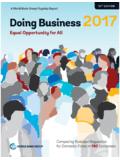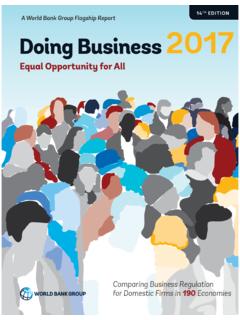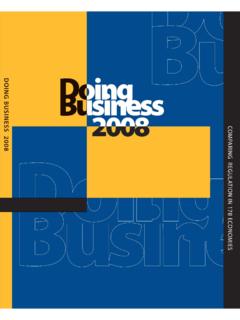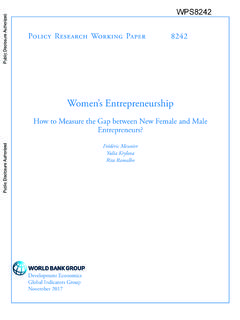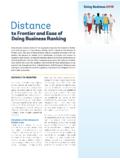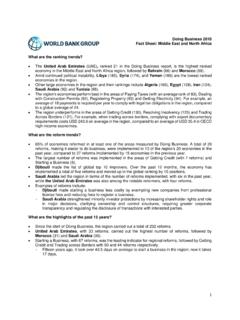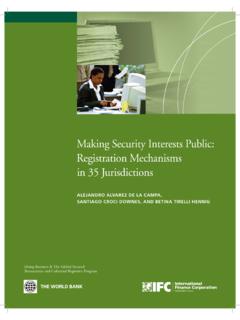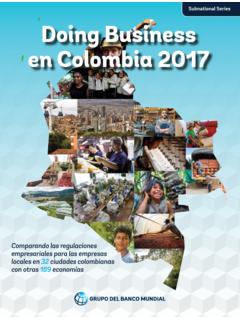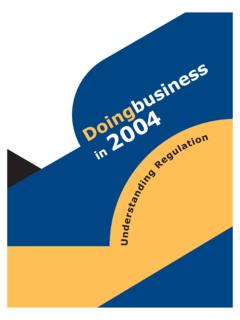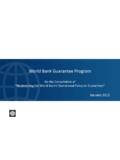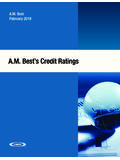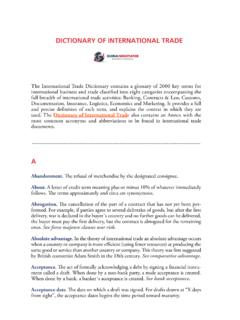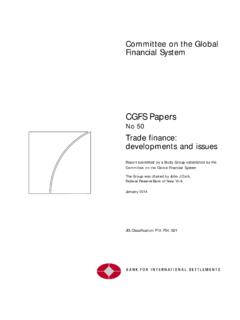Transcription of Getting Credit: Credit Information - World Bank …
1 Doing Business 2017 A comprehensive Credit reporting system that includes Credit history data from alternative sources in addition to banks is critical to the establishment of a well-developed and inclusive financial infrastructure. In economies where Credit bureaus or registries include data from retailers, utility companies and trade creditors, the average coverage of the Credit reporting system tends to be higher than in those where such Information is not available. OECD high-income economies and Latin America and the Caribbean have the largest proportion of economies where the main Credit reporting service provider distributes data from non-regulated entities. In 50 out of 190 economies measured by Doing Business the main Credit reporting service provider distributes data from utility companies in its reports.
2 At least one Credit reporting service provider reports repayment history from financing corporations or leasing companies in 110 economies worldwide. Reporting microfinance data benefits borrowers (by establishing repayment histories that help them obtain loans) and microloan lenders (by helping them assess the repayment capacity of their clients). Getting Credit : Credit InformationCasting a wide net to expand financial inclusionThe ability to access affordable Credit is a critical element of private sector-led growth. While fac-tors such as interest rates and collat-eral requirements play an important role in access to finance for firms and individuals, underdeveloped financial infrastructure increases the cost and risk of lending to both borrowers and financial services pro-viders.
3 A comprehensive Credit reporting system that includes Credit history data not only from banks but from other institu-tions such as trade creditors, leasing and factoring companies, retailers and utilities and microfinance institutions is critical in the establishment of a well-developed and inclusive financial This can be of special importance for developing economies where lower levels of institutional development reflected in weak judicial systems and creditor rights are associated with greater financing constraints and less developed Credit billion people currently lack access to formal financial , 42% of adults reported hav-ing borrowed money in the previous 12 months in the 2014 Global Findex the overall share of adults with a new loan formal or informal was fairly consistent across regions and economies, the source of new loans varied widely.
4 In OECD high-income economies financial institutions were the main source of financing, with 18% of adults reporting borrowing from one in the past year. By contrast, in develop-ing economies nearly a third (29%) of adults reported borrowing from family or friends, while only 9% reported bor-rowing from a financial institution. In the Middle East, South Asia and Sub-Saharan Africa more people reported borrowing from a store (using install-ment Credit or buying on Credit ) than from a financial institution. The gap in the Middle East was the largest, with close to 20% of borrowers having a retail store Credit and less than 10% having a loan from a financial to finance is a fundamental fac-tor affecting the growth opportunities of small businesses.
5 Globally, 27% of firms identify access to finance as a major While a quarter of firms use banks to finance investments, only 15% of these firms total investments are financed by banks, with 71% of invest-ments being financed internally, 5% by supplier Credit and 5% by equity or stock Compared to large firms, smaller firms finance a lesser share of their investment from formal sources, relying instead on informal sources such as bor-rowing from family and friends or from unregulated Around 70% of formal small and medium-size enterprises in developing economies are estimated to be either unserved or underserved by the formal financial The total Credit gap that they face amounts to $ to $ trillion, or $700 to $850 billion if firms in OECD high-income economies are A Credit reporting system that accounts for the diverse sources of finance for small and medium-size firms can contribute to a reduction of the Credit gap and the promotion of private sector growth.
6 59 Getting Credit : Credit INFORMATIONEXPANDING Credit ACCESS THROUGH COMPREHENSIVE Credit REPORTING Lenders and borrowers both individuals and firms benefit from sharing Credit Information with Credit reporting service providers (CRSPs). In economies where a larger share of the adult population is covered by CRSPs, more adults have a Credit card, borrow from a bank or other financial institution (figure ) and formal private sector lending is higher (figure ). This is consistent with earlier studies indicating that Credit reporting institutions are associated with higher ratios of private Credit to GDP across economies and that an improvement in Information sharing increases Credit lev-els over Higher economic growth rates and a lower likelihood of financial crisis are additional benefits associated with greater Credit It is impor-tant to note that the figures presented here describe an association between variables measuring Credit reporting systems and Credit market outcomes.
7 No causality is implied given the cross-economy nature of the firms tend to have bank loans or lines of Credit (figure ) and fewer rejections of loan applications (figure ) in economies where Credit bureaus and Credit registries have higher commercial borrower coverage. This finding is consis-tent with recent analysis using firm-level surveys of 63 economies covering more than 75,000 firms over the period from 2002 to 2013. Its results reveal that the FIGURE In economies where borrower coverage is higher, the levels of formal private sector lending are higher20406080100500150100 Credit bureau or registry coverage (% of adult population)Domestic Credit to private sector (% of GDP)Sources: Doing Business database; World Development Indicators database ( ), World : The sample includes 129 economies covered by both the Doing Business database and World Development Indicators database.
8 The relationship is significant at the 10% level after controlling for income per capita. FIGURE In economies where borrower coverage is higher, the share of adults with Credit cards and borrowing from financial institutions is larger0204060801002040608010015105202502 01030 Credit bureau or registry coverage (% of adult population) Credit bureau or registry coverage (% of adult population) Credit card ownership (% age 15+)Borrowed from a financial institution (% age 15+)Sources: Doing Business database; Global Findex database ( ), World : The samples include 106 and 130 economies covered by both Doing Business database and Global Findex database. Both relationships are significant at the 1% level after controlling for income per BUSINESS 201760introduction of a Credit bureau improves the firms likelihood of access to finance, with longer-term loans, lower interest rates and higher share of working capital financed by banks.
9 The study also finds that the greater the coverage of the Credit bureau and the scope and accessibility of the Credit Information , the more profound its impact is on firm sharing Credit Information Credit reporting helps to reduce Information asymmetries between creditors and bor-rowers. Borrowers typically know their financial abilities and investment oppor-tunities much better than lenders do. The inability of lenders to accurately assess the creditworthiness of borrowers contributes to higher default rates and smaller loan portfolios. Lenders are also more likely to lend to larger firms, which may be more transparent as a result of more elaborate legal and accounting rules and the regular publication of certified financial reports.
10 Credit reporting has been shown to decrease contract delinquencies and defaults, especially when firms are informa-tionally opaque, without loosening lending Studies suggest that, following the introduction of Credit reporting systems, repayment rates have risen when lending is for a single transaction and repayment is not enforceable by a third party, mainly because borrowers believe that a good Credit record improves their access to Credit . Credit reporting also affects market outcomes by weakening lenders ability to extract rents15 while leading to higher profits and lowering the risks to In addition, more advanced Credit reporting systems and greater financial sector out-reach are associated with a lower degree of tax evasion by an individual without an established Credit history, securing a loan from a formal financial institution can become a vicious circle.
